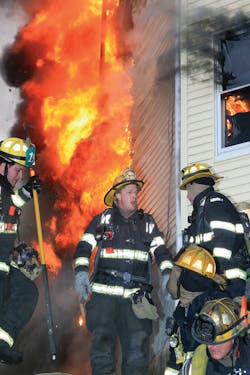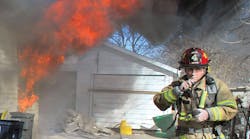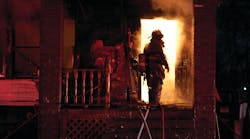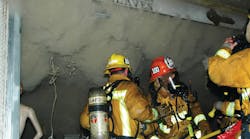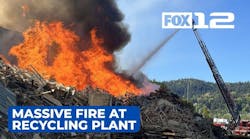Although the term “aggressive strategy” may be new, the concept is not. Consider the following.
My dad was hired as a firefighter in 1950. His academy graduation photo shows a dozen proud recruits posed in front of a brand-new, four-door, fully enclosed engine. At Station 10 in Long Beach, CA, my dad’s captain had a policy that qualifies as aggressive strategy: When the five-member crew of Engine 10 arrived at a building fire, the engineer (driver/operator) would chock and pump, the captain would do a size-up and the three firefighters would sit in their fully enclosed cab until the captain had completed the size-up, devised an initial plan and returned to assign the firefighters. My dad added that it was routine to squirt water at the fire through a window or open door – offensive benefit from a defensive position – before transitioning to an offensive position.
Fast-forward a couple of decades and strategic focus had been eclipsed by tactical speed. To accommodate the shift to tactical speed, apparatus doors were removed and airpack jump seats installed. (I’m surprised track meet starting blocks were not installed.) Fortunately, the doors have returned and seatbelts added. For some reason, during the intervening decades, it became important that firefighters quickly mingle with the heat rather than ensure that a master craftsman size-up was completed and initial action plan developed.
Fast-forward a couple more decades and today you will find the (so-called) incident commander advancing a hoseline within the hazard area! When did it become acceptable for an incident commander to operate inside the hazard area on a hoseline? Doesn’t the responsibility of advancing hoselines belong to engine companies? (More on this next time, when we “open” and discuss the contents of box four.)
A quick review
Back in January 2012, Firehouse® introduced this series of articles on “How to Nail Your First-Due Responsibility” with a discussion concerning REACTIVE TACTICS and PROACTIVE STRATEGIES and suggested it is time to recalibrate; to reboot the “system.” This series focuses on the concept of aggressive strategy, particularly by the first-on-scene company officer. The series identified “The Problem” and established a case for changing how the first on-scene fire officer does business. Subsequent articles identified the first-due company officer’s role and responsibility and offered a structured and systematic “Four Box” process. This article focuses on box three, “Paint the Picture.”
Before we jump into box three, however, let’s do a quick review of why this information is important and revisit the “contents” of boxes one and two.
• Box one – Arrival report. For a typical house fire, the box-one arrival report would sound like this: “Engine 11 on scene. House with fire showing. Side Alpha is Main Street. Engine 11 has a hydrant, initiating command in the investigation mode.”
• Box two: Focused strategy. The five elements in box two are:
1. Get firefighters going at task level (establish water supply, pump primed and ready, stretch handlines, etc.) Perhaps have a firefighter squirt the fire from a defensive position (offensive benefit from a defensive position).
2. Look for somebody to talk to (this could be done by your driver). Somebody to talk to includes the reporting party, evacuated occupants or the FedEx driver who called 9-1-1. Ask questions such as “Is everybody out and accounted for?” and “Do the smoke and fire conditions look different than when you called 9-1-1?”
3. Determine value-time-size (V-T-S). Is there value and where? How long will there continue to be value? How much water is required to extinguish the fire and protect exposures? Is the size of my response adequate and capable of preserving the value that exists now?
4. Identify and list the “big six” problems – fire, smoke, verified occupants, possible occupants, exposures and access.
5. Identify hazards such as overhead wires, Dobermans, septic tank or well covers and lightweight structural systems. An LPG tank would be listed as a big-six exposure.
Box Three: “Paint the Picture”
Box three is the radio report of what you discovered during your focused strategy in box two (Firehouse®, February 2013). Again, the reason there was not a big radio speech in box one is because an arrival report does NOT qualify as your size-up. Don’t try to paint an oral picture while peering through the windshield when you have not yet seen the whole picture; wait until your size-up is complete and you have had time to think. Once you know what the whole picture looks like, you will paint the picture by delivering a clear and concise state of the fireground address. Box three is opened after box two has been “closed.”
Here is what a typical box-three radio report would sound like: “Dispatch from Engine 54, update...(pause to make sure you have connected with the dispatcher). Large, two-story house. Fire floor two, smoke from attic, unknown if occupied. Engine 54 is transitional from side Alpha on floor two.”
Although clear and concise, the radio report is not a meaningless narrative; it is based entirely on the script that you drafted for this incident during box two. Your box-three script was based on the building and type of occupancy and problems identified during your big-six size-up.
Now, let’s examine each component of the preceding box-three radio report and finish with the drafting and implementation an initial action plan:
1. Building snapshot – “Large, two story house.” Now that you’ve viewed and assessed as much of the building and situation as possible, you will briefly describe – an oral snapshot – the building itself. Describe the general size, number of floors, type of construction and significant structural features or hazards. (Unless otherwise described, a “house” is lightweight wood frame.) When talking on the radio ALWAYS use the least number of words possible. Thus, “house” (one word) is preferable to “single-family residence” (three words). Also, in many cities there are multi-family houses.
2. Big-six report – “Fire floor two, smoke from attic, unknown if occupied.” This represents a condensed report of the big-six problems identified during your box-two size-up. You need only report a big-six component if there is a problem there. For the example, if there is no smoke or fire in an attic, don’t mention the attic; if the basement appears clear and stable, you need not mention the basement.
If you determine the status of life safety is (literally) unknown if occupied, you would report “unknown if occupied.” “Unknown if occupied” conveys the following important information:
? There is not a verified occupant who requires immediate rescue
? There is no compelling evidence for conducting search and rescue
? Should “offensive” be declared, it will be a coordinated in a two-in/two-out operation
? Life safety will be addressed with primary search (if occupant viability is determined). Recall from previous articles that primary search is not synonymous with search and rescue. Words should mean something.
3. Update operational mode – “Engine 54 is transitional from side A on floor two.” Declaring the mode “offensive” is a declaration that there are at least four personnel on scene (two-in/two-out). Never forget that, for the first time in history, declaring the mode “offensive” is a legal declaration of two-in/two-out compliance. We believe there should be a minimum of six personnel on scene before declaring the mode “offensive.” We also believe that five coordinated benchmarks must be achieved before declaring “offensive.” Thus, “coordinated offensive” means that:
? Water supply is established
? Ventilation that is effectively directing heat and products of combustion away from fire fighters and occupants has been achieved (ventilation in progress in not effective ventilation)
? A two-out standby team is in position with a charged hoseline
? A confine-and-extinguish team with a charged hoseline is ready to go
? There is an incident commander at a command post (not manipulating a hoseline or a power saw)
With a few caveats, these five benchmarks can be accomplished with six personnel. Caveats include that the method of ventilation is not vertical and two people are able to advance the offensive hoseline, factoring stairs, friction points and nozzle reaction. Transitioning to “offensive” with fewer than six personnel ratchets up the risk. Remember, firefighters always arrive with 100% value.
The six contemporary modes are represented by the acronym TRIPOD: transitional, rescue, investigating, preparing, offensive and defensive; of the six, the only one you likely never have heard is preparing. For more TRIPOD information, see the August 2007 issue of Firehouse® or send an email request to [email protected]. Be sure to mention TRIPOD.
4. Draft an initial action plan – This recommendation addresses the national consensus strategic responsibility identified by National Fire Protection Association (NFPA) 1021, Standard for Fire Officer Professional Qualifications:
4.6.1 Develop an initial action plan, given size-up information for an incident and assigned emergency response resources, so that resources are deployed to control the emergency.
4.6.2 Implement an action plan at an emergency operation, given assigned resources, type of incident, and a preliminary plan, so that resources are deployed to mitigate the situation.
In case you missed the significance, “fast attack” and “quick attack” DO NOT align with this national consensus standard. Fast (or quick) attack is the complete opposite of NFPA 1021, and is likely illegal without two firefighters standing by outside the IDLH (Immediately Dangerous to Life or Health) area. Also notice that the first-due officer is not required to develop the entire INCIDENT action plan, just the INITIAL action plan. Using our methodology, the initial action plan for a typical room-and-contents fire within a house would likely be the entire plan; it would not serve as the entire action plan for a multi-family complex with multiple occupancies suffering rapid oxidation.
Development of the initial action plan is the centerpiece of the whole strategic puzzle. Rather than try to produce an inflexible strategic checklist, we recommend a process that is simple, quick, intuitive and adaptable. The planning process ALWAYS begins with the identification of problems and hazards and the determination of risk versus value. In box two (Firehouse®, February 2013), we introduced the big-six size-up. Again the big-six problems are fire, smoke, verified occupants, possible occupants, exposures and access. Your action plan will emerge from the your V-T-S determination and the identification of these problems. The basic premise of the big six is this: If you don’t see it often, you often don’t see it. In other words, when was the last time you were the first-due fire officer at building fire? Let’s be honest – for many fire officers in North America, it has probably been a year.
If any part of fireground strategy must be structured and systematic, it is during size-up. It is unwise to rely on a “gut feeling” during size-up; it would be reckless to let your gut determine whether or not there’s fire in the basement. Drafting the initial action plan requires a strategic tool; just as firefighters must know how to use tactical tools, fire officers must know how to use strategic tools. We recommend the ITAC first-due status board shown (GRAPHIC 6 – WHERE?). Based on the house fire shown, the big-six problems are listed down the center. The problems are addressed using ITAC status board shorthand in the six boxes. Assignments are given face to face and passports are (literally) plugged into the action plan.
Because there are only six boxes on the board, your span of control cannot exceed one to six (1:6). For the house fire shown, the plan drafted on the board would likely be the entire action plan. For a more complex fireground, it would be what NFPA 1021 refers to as the initial and the preliminary action plan.
5. Implement initial action plan – Congratulations, you have completed a “master craftsman” size-up (you identified problems and identified hazards and developed the initial incident action plan). That qualifies as aggressive strategy. Now it’s time to implement that plan. This means you cannot be inside the building on a hoseline or on the roof with a power saw. You must be outside at a command post (perhaps established at your apparatus).
In the spirit of making the ongoing command foolishness cease, we would like to be clear: INCIDENT COMMANDERS DO NOT OPERATE AT TASK-LEVEL! Anybody with an Incident Command System (ICS) position designation should be outside the hazard area wearing a colorful vest while manipulating tools that contribute to aggressive strategy: accountability hardware and ICS position status boards. It is appropriate for company officers and team leaders to assist with the manipulation of tactical tools (hose, ladders, etc.). It is not appropriate for incident commanders, safety officers, division supervisors, group supervisors and branch directors to manipulate tactical tools
When the quarterback at your local high school calls a play in the huddle, 11 teenagers have been given assignments. The play selected by the coach is not based on “we always do this on third down”; it is based on a size-up that factors down, distance, score, quarter, time on the clock, which side of the 50-yard line, wind, field condition, etc. In the huddle the quarterback does not convey the size-up information factored to select the play called. When the play is called, each of the 11 players has been assigned and will carry out the assignment when the ball is snapped. If each of the 11 players is going to freelance, then providing size-up information in the huddle would be important and the play irrelevant.
Based on offensive or defensive position, each play has a pre-assignment for each of the 11 players. On the fireground declaring the operational mode can be the equivalent of calling a football play. There is an important distinction between a play assignment and a pre-assignment: with play assignments the players don’t freelance.
Next time: Box four
Box four, the final first-due box, is the establishment of a command post. During the opening of boxes one, two and three, the first-due fire officer had one foot in team-leader responsibility (tactics) and the other foot in command responsibility (strategy). When box four is opened, the fire officer will place both feet in command responsibility.
